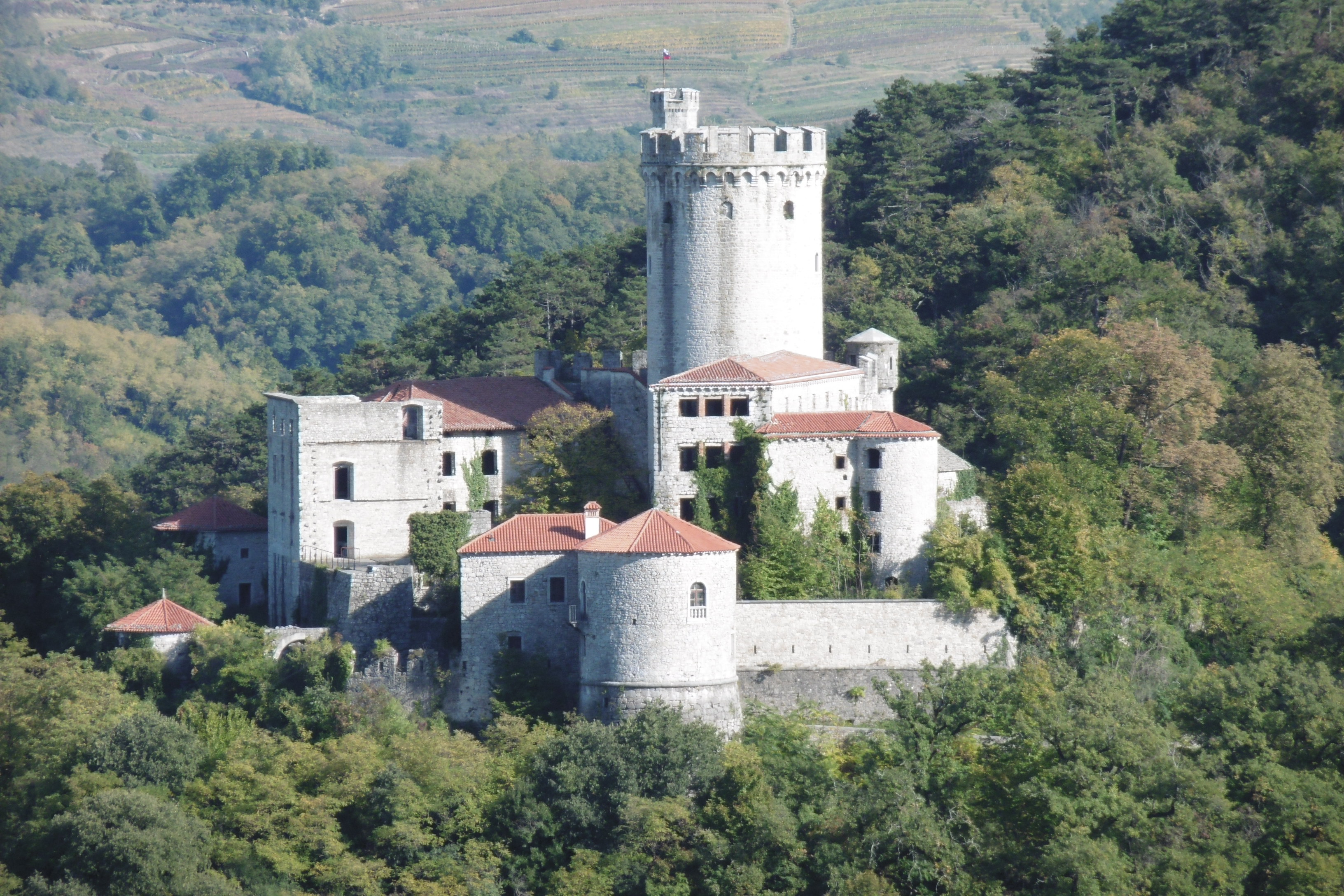Branik Castle on:
[Wikipedia]
[Google]
[Amazon]
 Branik Castle (, ), also known as Rihemberk Castle (''Grad Rihemberk'', ), is a 13th-century
Branik Castle (, ), also known as Rihemberk Castle (''Grad Rihemberk'', ), is a 13th-century
Vino Filipcic - aerial photo of castle
/ref> The building took its current shape in the 17th/18th centuries, when it was turned into a Baroque residence. Significant remodeling was carried out in the 19th century as well, notably the romantic crenellations of the walls. A partially preserved walled garden once occupied the south slope below the castle. The design of the entrance gate suggests the garden belongs to the Baroque period of the castle.
Image:GradBranik3.JPG, Branik Castle, main gate
Image:GradBranik1.JPG, Branik Castle, keep
Image:GradBranik2.JPG, Branik Castle, panorama
Branik Castle on GeopediaSatellite photo
{{coord, 45.8512, 13.7918, type:landmark_source:enwiki-googlemaplink, display=title Castles in the Slovene Littoral Urban Municipality of Nova Gorica
 Branik Castle (, ), also known as Rihemberk Castle (''Grad Rihemberk'', ), is a 13th-century
Branik Castle (, ), also known as Rihemberk Castle (''Grad Rihemberk'', ), is a 13th-century castle
A castle is a type of fortification, fortified structure built during the Middle Ages predominantly by the nobility or royalty and by Military order (monastic society), military orders. Scholars usually consider a ''castle'' to be the private ...
above the village of Branik, near the city of Nova Gorica
Nova Gorica () is a town in western Slovenia, on the border with Italy. It is the seat of the Municipality of Nova Gorica. Nova Gorica is a planned town, built according to the principles of modernist architecture after 1947, when the Treaty of pe ...
in southwestern Slovenia
Slovenia, officially the Republic of Slovenia, is a country in Central Europe. It borders Italy to the west, Austria to the north, Hungary to the northeast, Croatia to the south and southeast, and a short (46.6 km) coastline within the Adriati ...
.
History
Fortified settlements have been present on the hill above what is now the village of Branik since prehistoric times; the site was once occupied by a Roman castrum. The date of the founding of the castle is unclear, but the noble house of Rihemberk () is first recorded in 1230, originating from Riffenstein in Tyrol, now the castle of Reifenstein in Freienfeld, northern Italy. The name ''Rihemberk'' derives from the name of the family's former castle, and is a compound of the German words ''Riffe'' ("ridge") and ''Berg'' ("mountain"). The family received substantial properties in fief from the Counts of Gorizia, including estates in the Vipava Valley, the Karst Plateau, in the outskirts of the town ofGorizia
Gorizia (; ; , ; ; ) is a town and (municipality) in northeastern Italy, in the autonomous region of Friuli-Venezia Giulia. It is located at the foot of the Julian Alps, bordering Slovenia. It is the capital of the Province of Gorizia, Region ...
and elsewhere. The Rihemberg male line died out in 1371. In the 14th and 15th centuries the lordship contracted to the immediate surroundings of Rihemberk, a small part of the Vipava Valley, and the Karst Plateau. After the Counts of Gorizia died out in 1500, the castle passed to the Habsburgs. In 1528 both it and the surrounding lands were acquired by the noble house of Lanthieri, who added a residential palacio in 1649. The Lanthieris retained the castle for a full 417 years, until World War II
World War II or the Second World War (1 September 1939 – 2 September 1945) was a World war, global conflict between two coalitions: the Allies of World War II, Allies and the Axis powers. World War II by country, Nearly all of the wo ...
. On the night of 22 July 1944, the Partisans burned and dynamited the castle. All of its furnishings were destroyed. In 1945, the castle was nationalized. Since the 1980s, it has since been gradually restored, though all prewar structures have not yet been fully rebuilt.
In 1999, the castle was declared a cultural monument of national importance.
Architecture
The Romanesque foundations of the castle are still evident in some places. The castle complex is centered on a prominent 13th-century round keep, around which a substantialBaroque
The Baroque ( , , ) is a Western Style (visual arts), style of Baroque architecture, architecture, Baroque music, music, Baroque dance, dance, Baroque painting, painting, Baroque sculpture, sculpture, poetry, and other arts that flourished from ...
residential tract was later developed, all surrounded with Renaissance
The Renaissance ( , ) is a Periodization, period of history and a European cultural movement covering the 15th and 16th centuries. It marked the transition from the Middle Ages to modernity and was characterized by an effort to revive and sur ...
defensive walls and 16th century corner turrets. The older structures contain some Gothic elements, notably the castle chapel./ref> The building took its current shape in the 17th/18th centuries, when it was turned into a Baroque residence. Significant remodeling was carried out in the 19th century as well, notably the romantic crenellations of the walls. A partially preserved walled garden once occupied the south slope below the castle. The design of the entrance gate suggests the garden belongs to the Baroque period of the castle.
Gallery
References
External links
*Branik Castle on Geopedia
{{coord, 45.8512, 13.7918, type:landmark_source:enwiki-googlemaplink, display=title Castles in the Slovene Littoral Urban Municipality of Nova Gorica